|
|
Copyright and Trademark Information
|
|
The Plate Number Coil Catalog
Numbering System™
(Extracted from the Introduction of The Plate Number Coil Catalog)
Part 2 — Extending PNC Catalog Numbers™
In addition to the components of basic PNC Catalog Numbers described in Part 1, special extensions can be added to the right side of a PNC Catalog Number to indicate the length of a particular strip and/or the following sub-specialty characteristics and errors (when applicable):
The errors and varieties described by the PNC Catalog Number extensions fall into four primary groups—those that define location of a specific characteristic on the face of a strip of stamps, those that describe characteristics that appear on the face of the stamp, those that pertain to perforations or die cuts, and those that relate to characteristics found on the back of the stamp.
To accommodate the need for some collectors to combine extensions from more than one of these groups to properly describe a particular PNC, each extension group has its own type of separator to “frame” the individual extension component. The conventions for the extension separators are as follows:
[ ] — Squared brackets are used to “frame” a PNC Catalog Number extension component that defines the location of a specific characteristic on the face of a strip of stamps, such as a precancel gap, a tagging break, or an offset seam line.
( ) — Parentheses are used to “frame” an extension component that describes a characteristic that appears on the face of the stamp. This applies to plate number varieties, color-omitted errors and color varieties, tagging-omitted and tagged errors, number-on-top miscuts, and constant plate varieties.
< > — A pair of less-than and greater-than symbols are used to “frame” an extension component that pertains to a perforation or die cut variety (including imperforate errors, die cut omitted errors, die cut types and incision styles, misperfs, and large and small hole perforation varieties).
/ — A single forward slash is used at the left side of an extension component that relates to a characteristic found on the back of the stamp, which includes gum varieties (such as dull, low-gloss, and shiny) and counting back numbers. This extension should appear at the end (right-most component) of the overall PNC Catalog Number. This extension, therefore, does not have a right-side portion of the “frame.”
The particular conventions and formats associated with each of the individual PNC Catalog Number extension types listed above are described in the following sections. (The specialty descriptions are ordered by their relationship to the four primary extension groups listed above. No order of popularity or preference is intended.)
Precancel Gap Locations
Almost all overprinted precancels on PNCs include two horizontal bars as part of the precancel. The precancel bars appear as two parallel lines that span across all of the stamps in a coil. The lines are continuous except for small breaks (known as precancel gaps) that repeat at regular intervals as a result of the butting edges of the precancel mats, which are wrapped around the cylindrical precancel roller. Overprinted precancels produced on the BEP’s Cottrell presses show precancel gaps at 12-stamp intervals, and precancels printed on the BEP’s B press have precancel gaps that appear at 26-stamp intervals. Each of these intervals is equivalent to the width of the respective precancel mats.
![T4S-3P[1L]](images/T4S-3P-1L.jpg) |
Because overprinted precancels were applied in a continuous process that first printed and then precanceled the stamps, the relative location of the precancel gap to the joint line and/or the plate number of a coil remains constant throughout a coil of stamps. The relative location depends on press settings (the relationship between the engaged printing cylinder and the engaged precancel roller) when the press run was started. Some precanceled PNC issues were printed from more than one press run. With each press start-up or re-engaging of the precancel roller, the chances of a different precancel-gap-to-joint-line relationship was possible. If fact, many precanceled PNCs were produced with more than one precancel gap location. Some PNC collectors seek multiple precanceled strips of the same issue to demonstrate the different precancel gap locations that are known for the issue.
Distinct conventions have been developed for noting the locations of precancel gaps. Because precancel gaps typically appear in alignment with a row of perforations, conventions state that the precancel gap location is determined by finding the precancel gap nearest the joint line (which is located at the perforation row immediately to the right of the numbered stamp), and then counting the number of perforation rows to the left or right of the joint line. Hence, the precancel gap location is described as a 1- or 2-digit number (indicating the number of perforation rows to the left or right of the joint line) and an “L” or an “R” to signify whether the nearest precancel gap appears to “left” or “right” of the joint line. This description applies to all precancel gap locations except for precancel gaps that fall on the joint line row of perforations. This distinctive precancel gap location is referred to as “line gap,” which is denoted as “LG” in this catalog. Even though PNCs printed on the BEP’s B press do not exhibit joint lines, precanceled gaps from these PNCs maintain the same convention of referring to the precancel gap location relative to the joint line’s assumed location along the right side of the stamp bearing the plate number.
The location extension—a set of squared brackets containing the position designation—is appended to the right side of a PNC Catalog Number to identify a particular precancel gap location of a PNC with an overprinted precancel.
The following examples show how the extension transforms the general PNC Catalog Number for a PNC of the precanceled 4¢ Stagecoach from plate 3 (T4S-3P) to PNC Catalog Numbers for PNCs with the precancels at the 2-Left (2L) position, the 1-Left (1L) position, and the line gap (LG) position, respectively:
T4S-3P[2L]
T4S-3P[1L]
T4S-3P[LG]
Tagging Break Locations
Some PNCs with overall tagging exhibit thin untagged areas that repeat at regular intervals throughout the coil of stamps. These untagged areas are referred to as tagging breaks. They were produced by seams in the cylindrical surface that applies the taggant to the printed web.
Tagging breaks are only found on 11 issues from the Transportation Series. All of the issues were produced by the BEP—four were printed on a Cottrell (803) press, and the remaining seven were printed on the B (701), C (901), D (902), and F (801) presses. The different methods of applying tagging by the Cottrell press and the other group of presses form two primary groups of tagging breaks—each with slightly different tagging break characteristics.
Tagging breaks from the BEP’s Cottrell (803) press exhibit several different untagged bars and shapes that resulted from using a configuration of four modified precanceling mats to apply the tagging. The four modified mats (each covering 9 rows of 12 subjects) were arranged two over two around the tagging roller (which yielded a surface covering 432 subjects—18 rows high by 24 subjects around). The configuration of four mats, therefore, needed two revolutions to overprint the 864 stamp impressions produced from a single revolution of the paired printing plates on the impression cylinder of the BEP’s Cottrell press. This method produced untagged areas at the adjoining sides of the mats and where the mats’ mounting screws or clips were located. After the 18-row, printed web was processed into individual coils, each coil would show a repeating pattern of one of the following types of Cottrell-specific tagging breaks:
Bar — a vertical untagged area
Clip — a vertical untagged area with a rectangular untagged area near the top or bottom of the stamp
Screw — a vertical untagged area with a circular untagged area near the top or bottom of the stamp
Junction — the intersection of a vertical untagged area and a horizontal untagged area
In contrast to the Cottrell press, the BEP’s B, C, D, and F presses typically used two, paired mats that were magnetically held side-by-side around the circumference of a steel cylinder. This arrangement produced two untagged vertical bars (approximately 1–3mm in width) across the width of the printed web with each revolution of the stamp design’s impression cylinder. Because the B press had an impression circumference of 52 stamps, tagging breaks would appear in a coil at 26-stamp intervals. (The only exception exists on stamps from a B press printing of the 5¢ Circus Wagon coil from sleeve 1. A single mat was used to tag these stamps, so there is only one tagging break every 52 stamps—which is equal to one revolution of the impression cylinder.) The C, D, and F presses printed 48 stamps with each revolution of an impression cylinder; so tagging breaks from these presses appear at 24-stamp intervals.
Although two tagging breaks typically appear in alternating sequences throughout a coil, a PNC including the tagging break from the sequence that was nearest the plate numbered stamp (with two stamps past the break) is the desired collecting format.
The relative location of the tagging break to the plate numbered stamp depends on press settings (the relationship between the engaged printing cylinder and the engaged tagging roller) when the press run was started. Some PNC issues with tagging breaks were printed from more than one press run. With each press start-up or re-engaging of the tagging roller, the chances of a different tagging break location was possible. Because of this, all of the affected PNCs were produced with more than one tagging break location.
Some PNC collectors seek multiple strips of the same issue to show the different tagging break locations that are known for the issue. Collectors with specialized collections of tagging breaks try to acquire examples of each of the different tagging break patterns known for each of the affected Cottrell issues.
Distinct conventions have been developed for noting the locations of tagging breaks and the different Cottrell tagging break patterns.
Tagging breaks typically fall on a stamp (instead of the perforations). For this reason, a tagging break’s position is determined by its relative location to the stamp showing the plate number. By convention, the plate numbered stamp is the “1 Left” (1L) position. So, if the tagging break falls on the numbered stamp, it is a 1L tagging break. The stamp to the right of the numbered stamp is considered the 1 Right (1R) position. Specifying the location of tagging breaks further away to the left requires the counting of stamps (starting at the 1L position and continuing to the left) until the stamp showing the tagging break is reached. The location of the tagging break includes the number of stamps that were counted and an “L” to note the direction. Conversely, identifying tagging breaks further to the right requires counting the number of stamps (starting with the 1R position and continuing to the right) until the stamp showing the tagging break is reached. Similarly, this tagging break location identifier is the number of stamps counted with an “R” to show the direction from the numbered stamp. This method applies to all tagging break locations except for tagging breaks that fall exactly on a row of perforations. In this instance, the tagging break is designated as being “on perf,” and the stamps on either side of the perforation row are included in the location description. For example, if the tagging break is exactly centered on the row of perforations between the 2L and 1L stamps, the location is described as “2L/1L on perf.”
The location of a tagging break on a particular PNC can be denoted by adding a location extension to the general PNC Catalog Number for the strip. The notation should follow the distinct conventions described above for identifying the locations of precancel gaps and tagging breaks and be enclosed within brackets ( [ ] )—for example, [4L].
The following PNC Catalog Numbers illustrate the use of the location extension to identify particular tagging break locations:
T10CB-1ot[9R]
T10CB-1ot[10R]
T10CB-4ot[1L]
T$1-1ot[3L]
To accommodate the special tagging break patterns of the Cottrell press issues, the following abbreviations can be added to the location extension to provide additional information about the particular tagging break:
B — for a tagging break that only shows a vertical bar break
Ct — for a tagging break that shows a vertical bar with a clip at the top of the stamp
Cb — for a tagging break that shows a vertical bar with a clip at the bottom of the stamp
St — for a tagging break that shows a vertical bar with a screw at the top of the stamp
Sb — for a tagging break that shows a vertical bar with a screw at the bottom of the stamp
J — for a tagging break that shows the intersection of a vertical bar and a horizontal bar
The specialized Cottrell tagging break pattern identifier should be separated from the position identifier with a hyphen. The following examples demonstrate the proper format of the Cottrell tagging break pattern identifiers in extended PNC Catalog Numbers:
T2-2[2L-B]
T5M-3[3L-Ct]
T5.2-3[4L-Sb]
T17EA-1[2L-J]
Unlike the tagging breaks found on other issues, the tagging breaks of the 4¢ Steam Carriage are consistently located on or near the perforations.
Offset Seam Line Locations
PNCs produced by the offset method of printing sometimes show faint vertical lines between the printed image areas of the stamps in a coil. These faint lines are called seam lines. Although they are sometimes similar in appearance to joint lines (which are a characteristic of coils printed on the BEP’s intaglio Cottrell presses), seam lines are very different—and specific to offset printing. Seam lines are not always present in an offset printed coil. They appear when a small amount of ink collects at the worn or dirty edge of the offset transfer blanket and deposits onto the paper web with the ink for the image. Because seam lines are produced by the edge of the transfer blanket, if they are present, they will appear throughout the coil at a regular interval—which is equal to the image width of the blanket. A seam line may be comprised of multiple lines in the same location showing more than one of the colors used to produce the stamp image.
The location of seam lines on PNCs is counted by perforation rows left or right of the “zero” position—the vertical row of perforations at the right side of the plate numbered stamp.
The following examples demonstrate how the general PNC Catalog Number for a PNC of the 25¢ Honeybee from plate 2, R25H(D)-2, can be appended with a location extension to indicate seam lines at the 2-Left (2L) position, the 1-Left (1L) position, and the zero (Zero) position, respectively:
R25H(D)-2[2L]
R25H(D)-2[1L]
R25H(D)-2[Zero]
Plate Number Varieties
Several PNC issues exhibit distinct varieties of the same printed plate number (sleeve number or cylinder combination) within an issue. These varieties were caused by specific production changes or anomalies. The following paragraphs briefly describe some of the more commonly collected PNC plate number varieties and their correlating PNC Catalog Number extensions. The examples are grouped to show similar or related varieties.
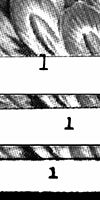 |
Modified Plate Numbers — After an initial printing, the intaglio-printed plate number 1 in each of the 18 rows of the intaglio printing cylinder of a combination Offset/C press printing of the 25¢ Honeybee coil stamp was manually shortened from .75mm to .5mm. This alteration was an attempt to minimize the overlap of plate number and the offset-printed, multi-color background. Because of this change in the height of the plate numbers, PNCs exist with the full-height plate number 1 from the original printing and the shortened (or cut) plate number 1 from the later printing. The manual alterations created many slightly different plate number 1s. Most of the plate numbers from the 18-row cylinder simply show a vertical stem with the top serif removed, but the bottom serif intact. Others have a tiny ball at the top or are slightly ragged. The plate number 1 from one of the 18 rows is known as the “truncated serif,” which—although it was shortened—shows a small serif at the top. The three main varieties of the 1 can be represented with PNC Catalog Numbers using extensions that include the term “full,” “cut,” or “serif” between parentheses, which is shown below:
R25H(O/C)-1(full) — for the full height (.75mm) plate number 1
R25H(O/C)-1(cut) — for the shortened (.5mm) plate number 1
R25H(O/C)-1(serif) — for the “truncated serif” variety of the shortened plate number 1
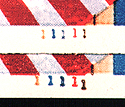
|
Thick and Thin Plate Numbers — The 32¢ Flag over Porch coil stamp with water-activated gum was produced by the BEP with 18-row cylinders to print large coils (of 500 and 3,000 stamps) and 20-row cylinders to print 100-stamp coils. The different cylinder heights matched the different processing equipment used to slit, perforate, and package the individual coils. The BEP used a set of five gravure cylinders—each printing one color—to produce the multi-color Flag over Porch design. One complete set of cylinders includes a tan cylinder, a light-blue cylinder, dark blue cylinder, a red cylinder, and a brown cylinder. Each of these cylinders printed one of the digits in the 5-digit cylinder combination found on a PNC. Because of the different cylinder height requirements, the BEP produced duplicate sets of cylinders—sets of 18-row cylinders and sets of 20-row cylinders—that replicated the use of 1s and 2s to produce full cylinder sets of 1s (11111) and 2s (22222). A difference in the production of the plate numbers on the 18-row cylinders and the 20-row cylinders caused the plate numbers (1s and 2s) on 18-row cylinders to be thinner than the plate numbers on the 20-row cylinders for the 1s and 2s. This comparative difference (“thick” or “thin”) can be used to identify PNCs from either set of cylinders. These descriptive terms “thick” and “thin” can be used in a PNC Catalog Number extension, as shown below, to differentiate these collectible FOP varieties:
F32wag-11111(thick) — from the 20-row cylinders
F32wag-11111(thin) — from the 18-row cylinders
F32wag-22221(thin) — from the 18-row cylinders
F32wag-22222(thick) — from the 20-row cylinders
F32wag-22222(thin) — from the 18-row cylinders
Similar varieties exist for the red 2 (middle digit) on PNCs of the 23¢ Presorted First Class coil stamp from American Banknote Corporation (ABN) showing cylinder combination A222. The two varieties for this PNC can be represented in the following manner:
S23PFC-A222(thick)
S23PFC-A222(thin)
Although the red 2 appears in another cylinder combination of the 23¢ Presorted First Class coil stamp produced by ABN (A122), the “thick” 2 only appears in the A222 cylinder combination.
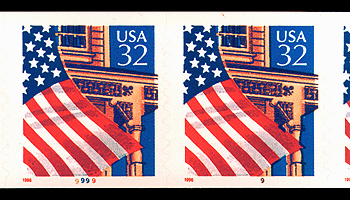 |
Split Plate Numbers — An extreme mis-registration—exactly the horizontal width of one whole stamp—caused one of the 5-digit cylinder combination numbers of the self-adhesive Flag over Porch coil stamp from rolls of 100 stamps to appear on the stamp next to the stamp with the other four numbers of the combination. This variety is only known to exist from cylinder combinations 55555 and 99999, and therefore is referred to as “Split 5s” and “Split 9s,” respectively. PNCs showing these two major plate number varieties can be described by PNC Catalog Numbers with a “(split)” extension. A hyphen ( - ) is also included in the Plate Number component of the PNC Catalog Number of these varieties to show the separated digit. The extended PNC Catalog Numbers for these two varieties are listed below:
F32psa-5-5555(split)
F32psa-9999-9(split)
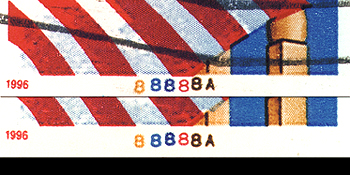 |
High and Low Plate Numbers — Some PNCs display plate numbers that are located nearer to the stamp image than other examples of the same plate number for the same issue. The relative location of the plate number is generally described as “high” or “low.” Variances in the plate number locations indicate that plate numbers were entered on the printing plate (sleeve or cylinder) in slightly different locations. These varieties are, therefore, specific to a particular row on the printing surface.
This type of variety can be described with an extended PNC Catalog Number that includes the appropriate “high” or “low” between parentheses. This is demonstrated in the following PNC Catalog numbers for this variety on PNCs of the Flag over Porch self-adhesive coil from rolls of 100 with the cylinder combination 88888:
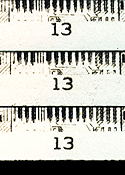 |
F32psa-88888(high)
F32psa-88888(low)
Three distinct plate number locations—high, medium, and low—exist for the 22¢ Flag over the Capitol from sleeve 13. To accommodate these varieties, the PNC Catalog Number extension can include the word “medium” as shown below:
F22-13(high)
F22-13(medium)
F22-13(low)
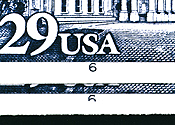 |
Partial Plate Numbers — The plate number of some PNCs of the 25¢ Yosemite coil and the 29¢ White House coils are missing the bottom portion of the digit because of poor inking. These plate number varieties are referred to as “partial numbers.” To identify PNCs of this variety, a set of parentheses around the word “partial” can be added as an extension to the right of the stamps’ PNC Catalog Numbers. The following examples demonstrate the use of this type of extension:
F25-2ep(partial)
F29WH-6(partial)
Flawed Plate Numbers — Some digits in PNC plate numbers exhibit flaws as a result of damage or wear to the printing surface. Like other constant plate varieties (CPVs), flawed plate numbers are usually specific to a particular row of stamps in a multi-row printing surface. Sometimes a flawed plate number exists with variations showing degenerative stages that developed during its use. Other flaws are consistent throughout the use of the printing plate (sleeve, or cylinder). Prominent plate number flaws typically are referred to by names that describe the appearance of the damaged digit. This descriptive name can be used between a set of parentheses as an extension to the PNC Catalog Number for the affected strip.
One prominent example of a flawed plate number is known as the “Broken Yellow 1.” It appears on the non-denominated (10¢) Eagle and Shield coil stamp produced by Stamp Venturers. The flaw makes the yellow cylinder number (1) appear as though its top was broken off. The yellow digit is the fourth digit in the 5-digit cylinder combination on this multi-color, gravure-printed issue. Only one of the nineteen rows from the yellow printing cylinder had the “broken” digit, but the yellow cylinder 1 was used in seven different cylinder combinations. The “Broken Yellow 1,” therefore, can be found in seven different cylinder combinations for the issue. Using the method described above, an extension can be added to the PNC Catalog Numbers for each of the affected cylinder combinations of this issue to identify PNCs with the flawed plate number.
S10ES-A11111(Broken Yellow 1)
S10ES-A11112(Broken Yellow 1)
S10ES-A12213(Broken Yellow 1)
S10ES-A21112(Broken Yellow 1)
S10ES-A21113(Broken Yellow 1)
S10ES-A22112(Broken Yellow 1)
S10ES-A22113(Broken Yellow 1)
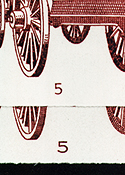 |
Re-used Plate Numbers — In an unusual occurrence, the BEP re-used plate number 5 on a printing sleeve for the single-color, intaglio-printed 3¢ Conestoga Wagon coil stamp instead of using the next number in the plate number sequence, which was 7. The plate number 5 that appears on a PNC printed from the first printing sleeve is slightly larger (in height and width) than the 5 on a PNC printed from the second sleeve. To distinguish this difference, an extension consisting of “(large)” or “(small)” can be added to the PNC Catalog Number for a strip showing plate number 5, where “large” identifies the larger plate number from the first printing sleeve, and “small” indicates the strip has a small 5 and, therefore, is from the second sleeve. This results in the following extended PNC Catalog Numbers:
T3CW-5(large)
T3CW-5(small)
Ink and/or Color Varieties, Color Errors, and Ink Mis-registrations
Some PNC issues exist with consistent color errors or varieties that are easily distinguished from the typical ink colors used to print each of the issues. Most of these color varieties were the result of ink contamination (when one ink color was inadvertently mixed with another—either by human or mechanical error). Other color variations were caused when different ink suppliers or formulas were used for the same color over the longevity of an issue’s printing. A few PNC issues were printed in small quantities with the wrong color of ink. In the instances when the wrong color of ink was used, the stamps are considered errors because they do not have any traces of the intended ink pigment. Regardless of the reason or whether the color difference was a contamination or the use of a wrong color of ink, each of these varieties and errors are usually referred to by a special name that references the color difference or the location where the variety was first found.
To accommodate these varieties and errors in the PNC Catalog Numbering system, an extension can be added to the general PNC Catalog number for the particular PNC. An extension for an ink/color variety or error is comprised of the commonly used name for the color variety/error or discernable difference enclosed between parentheses. Several examples are provided below:
F20-5(Slate Blue)
F20-8(Brick Red)
F22-4(Erie Blue)
F25-5(Black Forest)
F29MR-7(Toledo Brown)
T32-5(Bronx Blue)
Some PNCs were printed with luminescent ink, which is reactive to short-wave or long-wave ultraviolet (UV) light. Varieties of PNCs with luminescent ink can be described by a PNC Catalog number with an extension that includes the abbreviation “lum” enclosed between parentheses—as shown in the following examples:
T5CW-S2(lum)
T12.5-1P(lum)
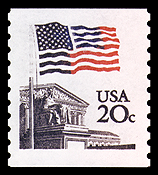 |
Two types of ink mis-registration can occur on multi-color coil stamps. One type is caused by the lack of alignment between the inking-in roller and the single intaglio printing sleeve. The other type of ink mis-registration is the result of a lack of synchronization between the individual printing surfaces used for each of the colors that compose a multi-color image. Severe mis-registration from either of these types can cause a drastic appearance in the resulting image. PNCs that show prominent ink mis-registration are typically referred to by distinctive names assigned by the finder of the particular example. These names can be used with parentheses in an extended PNC Catalog Number to identify PNCs showing these varieties.
The following PNC Catalog Numbers demonstrate the use of an extension to identify mis-registration varieties:
F20-10(Illinois Shift)
R25H(O/C)-1(Fast Bee)
R25H(O/C)-1(Slow Bee)
Color Omitted Errors and Ink Starvation Varieties
In rare instances, coil stamps from PNC issues have been found that are completely missing one or more of the colors that make up the stamp’s printed image. Most of these rarities are only known as used singles without plate numbers. A few, however, exist as PNCs.
One color omitted error that exists in mint, numbered strips is the 20¢ Flag over the Supreme Court with the black omitted. Oddly, the plate number, which repeats every 52 stamps, does not appear because it was suppose to be printed with the omitted (black) ink. However, plate strips of this error have been reported because the plate number (5), appears as a colorless, embossed (raised), intaglio impression.
In contrast, when a color is omitted on a multi-color, gravure-printed stamp—such as the 33¢ Flag over City self adhesive coil with the light blue and the yellow omitted—no colorless impression of the cylinder number for the omitted color is created. The number for the omitted color is simply not present. In the example cited above, the cylinder combination shows a blue 6, two blank spaces for the missing digits (the light blue 6 and the yellow 6), and the red 6.
PNC Catalog Numbers can identify color-omitted errors by adding an extension that includes the name of the color that is omitted and the term “omitted” between parentheses. Examples of PNC Catalog Numbers using this type of extension to indicate color-omitted errors are listed below:
F20-5(black omitted)
F33-6666(light blue and yellow omitted)
R25H-2(black intaglio omitted)
R32YR-7777(black omitted)
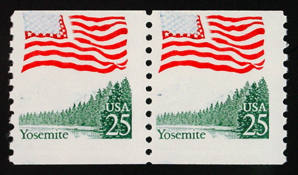 |
Some PNC varieties caused by ink starvation—when the ink fountains of a press clogged or ran dry—resemble color-omitted errors, but they exhibit some trace of the intended ink color. Examples of ink starvation are sometimes predecessors of true color-omitted errors. Nonetheless, ink starvation examples are usually stunning in appearance and considered highly collectible—although not demanding the premium of a color omitted error.
Refrain from using “almost color omitted” or similar phrases to describe ink starvation examples. Instead, use the name commonly used to refer to the particular ink starvation variety, or use the term “under-inked” and identify the affected color(s) or design element(s).
The following extended PNC Catalog Numbers show various ways to identify ink starvation varieties.
T10CB-5(under-inked) — under-inked example of the single-color, intaglio printed 10¢ Canal Boat from sleeve 5
F25-4(Misty Mountains) — multi-color intaglio printing of the 25¢ Flag over Yosemite from sleeve 4 with under-inked blue (commonly referred to as the “Misty Mountains” variety), which lessens the appearance of Yosemite’s Half Dome in the background and the flag’s field of stars in the foreground
R25H(D)-2(under-inked frame and denom.) — PNC of the D-press printing (combination offset and intaglio) of the 25¢ Honeybee from intaglio sleeve 2 with an under-inked frame line and denomination, which is the black portion of the offset printing
Each of the above examples, as with most ink starvation varieties, exists in varying degrees of under inking—from minimal to severe.
Tagging Omitted/Tagging Errors
Small quantities of some PNCs that were intended to have overall or block tagging were accidentally produced without any trace of tagging. The complete lack of tagging on the stamps occurs because the tagging station, which is the last step in the printing process, either ran dry, became clogged, or was disengaged. These stamps are referred to as “tagging omitted errors” and are considered highly collectible.
Tagging omitted errors can be described by adding a “tagging omitted error” extension to the right side of the PNC Catalog Number for the particular stamp. The extension consists of “no tag” (for no tagging) between a set of parentheses. It is important to understand that none of the stamps in the strip—which was intended to be issued with tagging—can show a trace of tagging for the PNC to be a tagging omitted example.
The use of this extension is shown in the following PNC Catalog Numbers that describe tagging omitted errors:
T2-8(no tag)
T15-2(no tag)
R20CE-3(no tag)
R20CE-4(no tag)
In contrast, some PNCs that were intended to be issued without tagging were wrongly produced with tagging—some from contamination of an issue’s lacquer coating with phosphorescent taggant and some from the unintended use of phosphored paper. These stamps are referred to as “tagged errors.” They are also highly collectible.
A tagged error can be described by adding a “tagged error” extension to the right side of the PNC Catalog Number for the particular stamp. The extension consists of “tag” between a set of parentheses. Following this convention, a PNC Catalog Number for a plate strip of stamps that were intended to be issued without tagging, but shows the presence of tagging throughout the strip would include the “(tag)” extension to identify the strip as a tagged error.
This extension is used in the following examples to denote tagged errors on PNCs that were only intended to be issued without tagging:
S5Mwag-11111(tag)
S10ES-22221(tag)
S23USA-1111(tag)
Number on Top Miscuts
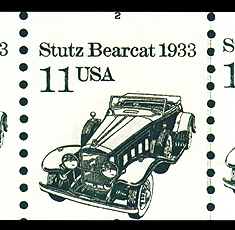 |
Misalignments of the slicing wheels that separate a printed web into individual coils sometimes cut coils above or below the intended location. These misalignments, therefore, have produced PNCs where the plate number is either split between the bottom and the top or wholly at the top. PNCs with split numbers are generally considered poorly centered and, therefore, not collected. In contrast, whole number-on-top examples were infrequently produced and are collected as a specialty of PNCs.
To indicate a number-on-top PNC, a “(top)” extension can be added to the right side of any PNC Catalog Number. The following examples show the PNC Catalog Number for a normal strip of the 12¢ Stanley Steamer from plate 3 and the extended PNC Catalog Number for a similar strip with the number on top:
T12-3
T12-3(top)
Constant Plate Varieties
Constant Plate Varieties (CPVs) are unintended marks or voids in a stamp’s printed image that repeat at regular intervals throughout a coil. CPVs are usually produced by deformations (scratches, cracks, chips, or other irregularities) in the printing surface.
CPVs are typically small and, therefore, usually only affect one stamp image on the printing surface. However, some CPVs laterally span across more than one stamp in a coil or vertically extend through more than one row in the printed web. In the latter circumstance, the CPV is split into upper and lower portions as the printed web is slit into individual coils.
A prominent CPV usually attains a recognizable, unique name that describes its printed appearance as it relates to the subject of the stamp. One example is the “Buggy Whip” CPV on the numbered stamp [1L] of plate 4 of the 4.9¢ Buckboard coil stamp. It is a vertical plate crack that extends from the side of the seat of the buckboard towards the lettering at the top of the stamp. Other CPVs have less creative names—such as “diagonal gouges at 2L” plate 2 for the Cottrell press version of the 4¢ Stagecoach.
The unique CPV names can be used in extension of PNC Catalog Numbers to describe PNCs that exhibit these printing flaws. The CPV extension consists of the CPV name between parentheses. This extension is added to the right of the general PNC Catalog Number for the strip—as demonstrated in the following examples:
F20-14(Q line)
F20-14P(Q line)
T4.9-4(Buggy Whip)
T18-1(Lightning Bolt)
In multi-color gravure-printed issues, the same CPV may appear on PNCs from the same issue that have different cylinder combinations. This occurs when the affected cylinder remains in use as other cylinders are replaced, which results in the new cylinder combination. This occurred with the “Bullet Hole” CPV on the self-adhesive 32¢ Flag over Porch coil stamp produced by the BEP in rolls of 100 stamps. The “Bullet Hole” CPV is a flaw on the (#8) gravure cylinder that printed the brown ink (The brown “8” is the last digit in the 5-color cylinder combination). This CPV is a spot of brown ink that appears near the top of the post on the porch in the stamp design. The flawed brown cylinder was used in seven different cylinders combinations for this 5-color issue. Several examples are listed below to show how this one CPV can be described in extended PNC Catalog Numbers for different PNCs:
F32psa-87888<11/10>(Bullet Hole)
F32psa-88898<10/10>(Bullet Hole)
F32psa-89888<11/10>(Bullet Hole)
Perforation Varieties
Although the measured gauge of perforations (determined by the number of perforations that appear in a distance of 2 centimeters) has remained stable at 9.8 throughout the life of PNCs, a small number of PNC issues have holes that vary in diameter from other examples within the same issue. These variations in perforation hole dimensions are typically divided into two comparative categories—large holes and small holes.
Some PNCs from the 20¢ Flag over the Supreme Court and the 22¢ Flag over the Capitol coil issues produced by the BEP exist as large or small hole varieties. The hole diameter variation of these issues is attributed to the introduction of new perforation equipment at the BEP during the production of these issues.
Although Sennett Security Products (SSP) produces perforation holes in their coils using a method called skiving, which shaves away the paper to form the hole instead of the traditional method of punching out the paper, some PNCs from them also exhibit large and small hole perforation varieties. Some PNCs from Sennett Security Products have perforation rows that show one size (large or small) of holes in the top half and the other size hole making up the bottom half of the perforation rows. These hybrid examples sometimes form odd shaped holes—referred to as “snowmen”—where the two sizes overlap in each of the perforation rows.
Large and small perforation hole varieties can be specified in a PNC Catalog Number by adding a specialized extension comprised of the term “large” or “small” between a set of less-than and greater-than symbols ( < > ).
The following extended PNC Catalog Numbers illustrate the use of the this extension to identify large or small hole perforation varieties:
F20-9<large>
F20-9<small>
S5Wwag-S1111<large>
S5Wwag-S1111<small>
A PNC that has the “snowmen” hybrid perforations can be described by a PNC Catalog Number with an extension formed with a set of less-than and greater-than symbols that includes both terms (“large” and “small”) separated by a slash ( / )—where the first term indicates the top hole size, and the term after the slash indicates the lower hole size. The PNC Catalog extension, therefore, would be “<large/small>” for a PNC with large holes in the top half of the perforation rows and small holes in the lower half. Conversely, “<small/large>” would be used to describe a PNC with small holes in the top half and large holes in the lower half.
Die Cut Types, Incision Styles, and Shoulder Cuts
The introduction of coil stamps with pressure-sensitive adhesive (PSA)—also known as “self-adhesive coil stamps”—required a new means of separating the individual stamps of a coil. Initial self-adhesive coils, which were solely produced for philatelic purposes, used straight die cuts between the stamps. The first mass production PSA coil stamps (the 32¢ Flag over Porch), however, used a vertically oriented serpentine die cut between the stamps. Each of the vendors that produce stamps for the USPS uses slightly different configurations for die cut patterns. The serpentine die cut pattern used by the BEP transitioned through several configurations prior to reaching the desired pattern of peaks and valleys that provided durability so that the stamps would not separate during processing and allowed easy separation during customer use. In addition to the intended varieties that were produced during this transition period, unintended varieties were also produced from inverted die cut mats and minor differences in production methods.
Primary die cut differences for a particular issue can be easily determined by the number of peaks (and valleys) that appear on either side of a stamp—and sometimes which pattern segment (the peak or the valley) appears at the top and bottom of the die cut on each side of a stamp.
If the die cut variety of a particular PNC can be distinguished solely by the number of peaks on each side of the stamp (when compared to other die cut varieties for the issue that have the same plate number), a simplified die cut extension can be added to the PNC Catalog Number for the strip. This extension would consist of the less-than ( < ) and greater-than ( > ) signs surrounding the number of peaks found on the left side of the stamps in the strip and the number of peaks found on the right side. By convention, the peak counts are listed with the count from the left side first, followed by a forward slash ( / ) and then the count from the right side. For example, a strip with 11 peaks on the left side of the stamps and 12 peaks on the right would be designated in the following manner: <11/12>. (An “L” or an “R” is not required in this designation because the peak count from the left side of the stamp always appears on the left side of the slash, and peak count from the right side always appears to the right of the slash.)
The following PNC Catalog Numbers demonstrate the use of the simplified die cut extension to identify the different die cuts known to exist for cylinder combination 66666 of the self-adhesive 32¢ Flag over Porch coil produced by the BEP (with the red 1996 year date):
F32psa-66666<12/12>
F32psa-66666<11/12>
F32psa-66666<12/11>
F32psa-66666<11/10>
F32psa-66666<10/11>
When the same die cut peak count exists in more than one pattern for an issue, the die cut extension needs to identify the die cut shape (either a peak or a valley) at the top and bottom of the serpentine die cut on the left and right sides of the stamps in the strip.
By using a “P” to identify a peak and a “V” to identify a valley, the following abbreviations describe the possible arrangements of a serpentine die cut:
PP — (peak-peak) a serpentine die cut with a peak at the top and a peak at the bottom
VV — (valley-valley) a serpentine die cut with a valley at the top and a valley at the bottom
PV — (peak-valley) a serpentine die cut with a peak at the top and a valley at the bottom
VP — (valley-peak) a serpentine die cut with a valley at the top and a peak at the bottom
These abbreviations can be added to left and right peak counts used in the structure of a die cut extension (described above) to define the specific die cut pattern found on the left and right sides of stamps in a strip.
The following examples use the die cut pattern abbreviations in the PNC Catalog Number extensions to identify two die cut varieties of strips with the same peak counts:
F32psa-22222A<10PV/10VP>
F32psa-22222A<10VP/10PV>
Minor differences can be determined by the presence, absence, or pattern of the ties that run across (or bridge) the die cut. (These ties maintain small connection between the stamps to maintain durability of each coil during processing.) These differences are collectively called die cut incision styles. The distinct incision styles are referred to as “Style A,” “Style B,” “Style C,” and “Style D.” The description for each style is listed below.
Style A — has ties in the serpentine die cut, but no ties in the straight top and/or bottom die cut
Style B — has closely-spaced ties (approximately 9 per peak) throughout the complete die cut
Style C — has no ties in the serpentine or straight portions of the die cut
Style D — has widely-spaced ties throughout the complete die cut. Style D exists in a normal and inverted arrangement, as follows:
Normal – Tie Tip Left (TTL) — a tie appears at the tip of each peak on the left side of the stamp. There are three ties per peak on the left side of the stamp and two ties per peak on the right side of the stamp.
Inverted – Tie Tip Right (TTR) — a tie appears at the tip of each peak on the
right side of the stamp. There are two ties per peak on the left side of the stamp and three ties per peak on the right side of the stamp.
The die cut incision style of a specific PNC can be incorporated into the PNC Catalog Number by adding a style designation (a lower-case letter —a, b, c, or d) to the right of the die cut extension. This is shown in the following examples, which list extended PNC Catalog Numbers for a stamp that exists with only one die cut pattern, but three different incision styles:
F32psa-11111<10/10a>
F32psa-11111<10/10b>
F32psa-11111<10/10c>
Another die cut difference is found on some PSA stamps produced by the BEP in large coils (3,000-stamp rolls and larger) with spacing between the individual self-adhesive stamps. This die cut difference appears as either a square shoulder (right angle) or a round shoulder (curved) transition where the peaks and valleys of a serpentine die cut becomes a short, straight die cut near the top and bottom of a stamp. Some plate numbers for these issues exist in both varieties, but some plate numbers exist in just the round shoulder die cut or just the square shoulder die cut.
The shoulder die cut of a particular PNC can be specified by adding “<round>” or “<square>” to the right of the PNC Catalog Number for the strip.
The following examples show the use of this extension to identify round or square shoulder die cuts:
S5W[psa]-2222<round>
S5W[psa]-2222<square>
S10B[psa]-444<round>
S10B[psa]-444<square>
As the above examples demonstrate, the same plate number for a PNC can exist in round shoulder and square shoulder varieties.
Imperforate and Die Cut Omitted Errors
Coil processing equipment or inspection processes sometimes fail, and PNCs are produced without perforations or die cuts and distributed in error. These errors are referred to as “imperforate errors” or “imperfs” for stamps with water-activated gum, and “die cut omitted errors” or “DCOs” for stamps with pressure sensitive adhesive (PSA).
An imperforate or die cut omitted PNC error can be identified using a PNC Catalog number with the appropriate extension. Add the term “imperf” between a set of less-than and greater-than symbols ( < > ) to denote an imperforate error. To describe a die cut omitted error, append the abbreviation “dco” between the less-than and greater-than symbols.
The following PNC Catalog Numbers illustrate the use of extensions to identify imperforate and die cut omitted errors, respectfully:
C25E-1211<imperf>
F32psa-78777<dco>
R32YR-5555<dco>
Because imperforate errors and die cut omitted errors are the product of mechanical coil processing, these errors are sometimes miscut as the printed web is sliced into individual coils. Imperforate errors and die cut omitted errors that are also miscut can be described using a PNC Catalog Number with the applicable extension—either “imperf/miscut” or “dco/miscut.” These extensions are used in the following PNC Catalog Numbers to identify imperforate and die cut omitted errors that are also miscut:
F29MR-4<imperf/miscut>
T16.7-1<imperf/miscut>
F33psa-3333<dco/miscut>
Misperf and Shifted Die Cut Examples
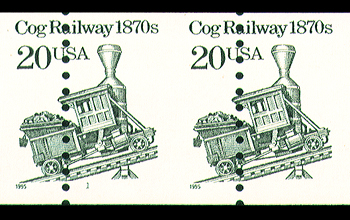 |
Examples of some PNCs exhibit drastically misplaced perforation rows or laterally shifted die cut patterns that run through the printed image area of the stamps. Occasionally, special die cut shapes—which are intended to fall at the area where the web is slicing into individual coils—appear along the edge of some coil stamps because the die cut was shifted up or down. Misperfs and shifted die cuts can occur in varying degrees—the most pronounced being a 50 percent shift left or right, which results in the perforations or the die cut being located at the vertical center of the stamp.
A misperf or a shifted die cut example of a PNC can be identified using an extension on the general PNC Catalog Number for the issue. The extension consists of the appropriate term (either “misperf” for a perforated stamp or “shifted” for a die cut stamp) framed by a set of less-than and greater-than symbols ( < > ). The amount of a vertical displacement of a die cut can be quantified using “shifted-up” or “shifted-down” as the extension term (following the assumption that any displacement above the midpoint of the side of the stamp was shifted down and any displacement below the midpoint was shifted up).
The following PNC Catalog Numbers include extensions to describe a misperf, a laterally shifted die cut, and a vertically shifted die cut, respectively:
T2-3<misperf>
R37SOLpsa-4444<shifted>
F32psa-99999<shifted-up>
Water-Activated Gum (WAG) Varieties
Some PNCs with water-activated gum (WAG) exist with more than one type of gum or are known with more than one gum finish. PNC gum varieties are commonly segregated into the following groups: dull, low-gloss, and shiny. These terms can be used as an extension of a PNC Catalog Number to describe a PNC’s gum. Because gum is a feature that appears on the back of stamps, the PNC Catalog Number extension should be preceded by a forward slash ( / ) and appear at the far right of the extended PNC Catalog Number. The following examples for the B press version of the 1¢ Omnibus demonstrate the use of this extension:
T1(B)-3/dull
T1(B)-3/low-gloss
T1(B)-3/shiny
Intaglio-printed PNCs with dull gum can be further categorized by distinctive characteristics that identify the company that manufactured and/or supplied the paper. One of the characteristics is the gum’s texture. The different textures are unique for each of the paper manufacturer/suppliers. Collectively, the different dull gum intaglio papers are referred to as “paper types.” Paper types have been classified as “Type I,” “Type Ia,” “Type II,” “Type IIa,” “Type III,” “Type IIIa,” “Type IIIb,” “Type IIIn,” and “Type IV.” If required, the Roman numeral and the sub-type designation (for example, IIIn) could be appended to PNC Catalog Numbers to identify these varieties—as in the following examples:
T16.7-2/IIIb
T16.7-2/IIIn
T17EA-3/I
T17EA-3/II
Back Number Varieties
Some stamps from large coils (of 500 or more stamps) have back numbers (sometimes referred to as “counting numbers”) printed on the back of the stamps (on top of the gum). On self-adhesive stamps, back numbers are printed on the liner (which is also known as “backing paper”). The back numbers are intended to aid postal clerks in managing their inventory of coils by providing a quick means of determining the number of stamps remaining on an open roll.
Four different stamp suppliers have produced coils with back numbers. Each supplier has a unique methodology for applying back numbers. These methodologies are described below:
Avery Dennison — 5-digit back numbers on every stamp. The numbers decrease by 1 with each appearance through the roll. Back numbers are only printed in aqua colored ink.
Banknote Corporate of America (BCA) — 5-digit back numbers at 10-stamp intervals. The numbers decrease by 10 with each appearance through the roll. Back numbers are only printed in black ink.
Bureau of Engraving & Printing (BEP) — 4-digit back numbers (regardless of roll size) at 20-stamp intervals. The numbers decrease by 20 with each appearance through the roll. Back numbers are printed in aqua or pink ink.
Sennett Security Products (SSP) — 3-digit numbers on rolls of 500 stamps (ranging from 010 through 500), 4-digit numbers on rolls of 3,000 stamps (including 0010 through 3000), and 5-digit numbers on rolls of 10,000 stamps (spanning 00010 to 10000, inclusive) that appear at 10-stamp intervals. The numbers increase by 10 with each appearance through the roll. Back numbers are printed in aqua, black, pink, or purple ink.
Back numbers typically are located near the top or bottom on the back of stamps. However, varieties exist that are in the middle of stamps, printed upside down, or doubled—with a number printed at the top of a stamp and the same number repeated at the bottom.
The majority of back number collectors have focused their interest in back numbers that appear on the backside of plate strips of 5 stamps (PS5s). Accordingly, they also adopted a unique method of describing the location of a back number on a PS5. It defines a back number’s location by the stamp on which it appears in the PS5. By convention, the stamps are referred to as “position 1,” “position 2,” “position 3,” “position 4,” and “position 5” (reading from left to right as you look at the back of the strip). For example, if the back number appears on the center stamp of the strip (the back of the plate numbered stamp), it is said to be located on “position 3.” This location—on the back of the plate numbered stamp—is also referred to as the “number-on-number” position, and it is the preferred location for most back number collectors.
Most of the specialized characteristics of back numbers can be described by adding an extension to the general PNC Catalog Number for the strip. Because back numbers are a PNC variety that appears on the back of stamps, the PNC Catalog Number extension should be introduced by a forward slash ( / ) and appear at the far right of the extended PNC Catalog Number. By combining the “/” with a small set of back number extension components, a general description for a type of back number can be described, or—if desired—the extension could show specific back number characteristics for a particular PNC. These components and their different uses are described below.
To describe a PNC with a basic back number, the following PNC Catalog Number extension components are required after the “/”:
the number of digits in the back number:
· 3
· 4
· 5
the location (and orientation, if upside down) of the back number on the stamp:
· T — for top
· B — for bottom
· M — for middle
· D — for doubled
· Tu — for top and upside down
· Bu — for bottom and upside down
· Mu — for middle and upside down
and the back number’s color:
· aqua
· black
· pink
· purple
By combining these components to form the extension (with a hyphen to separate the color component), a PNC Catalog Number can identify a basic back number as illustrated in the following examples:
R34SOLwag-1111/4B-aqua
S10B[psa]-222/4B-aqua
S25Dwag-S11111/5B-pink
To specify a specific back number for a particular PNC, the actual digits can be used in the extension as a substitute for the number of digits in the back number, and an abbreviation for the back number position in a PS5 can be appended (using a hyphen to separate it from the color component.) The following expanded PNC Catalog Numbers show how this format of the extension can be used to identify specific back numbers on PNCs:
R34SOLwag-1111/1260B-aqua-pos1
S10B[psa]-222/8660B-aqua-pos3
S25Dwag-S11111/09270B-pink-pos2
Strip Length
Lastly, the length (number of stamps in a continuous strip) of a PNC can be included as an extension to its PNC Catalog Number. This extension option is helpful in recording items already in your collection or communicating specific items on your want list.
If used, this extension should appear at the end (right-most component) of a PNC catalog Number. This extension is comprised of a hyphen ( - ) followed by the standard convention to denote the length of a PNC strip—“PS” (which is the abbreviation for “plate strip”) and the number of the stamps in the continuous strip of stamps.
Examples of PNC Catalog Numbers that show the strip length are listed below:
F18-6-PS1
O20-1-PS3
C33H[psa]-1111-PS5
F25-9bt<imperf>-PS6
T17EA-3Pba[4R]-PS12